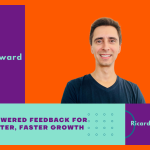Most B2B websites fail to convert visitors because buyers can’t find what they need. Aimdoc changes that—using AI to answer questions, qualify leads, and drive conversions instantly. Founder Ben Skoog shares how his background in sales and engineering led to Aimdoc, why traditional live chat falls short, and how AI is reshaping inbound sales.
1. What inspired you to create Aimdoc, and how does your background influence the platform’s focus on AI-powered sales automation?
Ben Skoog: I’ve spent most of my tech career bridging sales and product/engineering, serving as a liaison between them. In every single role, repetitive customer questions would be relayed by our sales team on a nearly daily basis. Aimdoc was initially built as a sales enablement tool to provide teams with just-in-time knowledge, but it soon became obvious that this “just-in-time” knowledge could easily be provided to potential customers. Serving this information to customers has a tangible revenue impact and provides a streamlined experience for both buyers and sellers.
2. How does Aimdoc revolutionize inbound engagement compared to traditional live chat or CRM tools?
Ben Skoog: At its core, Aimdoc seeks to provide a comprehensive alternative experience to a company’s website. Customers don’t want to dig around or use legacy keyword searches to locate information that qualifies your product or solution. Aimdoc provides an instant answer based on your data and a compelling next action for your prospective buyer to take. It strategically collects the right information and routes the visitor accordingly.
Traditional live chat has latency and scaling problems. We’re all tired of seeing “We’ll be back tomorrow” or “Usually responds in 30 minutes”. As your business grows, you need to hire more agents. This doesn’t scale well in terms of cost. Aimdoc can handle many complex conversations at a time and can be 10-20x cheaper. Additionally, the “chatbots” of the last decade have left a bad taste in everyone’s mouth. Pre-programmed flows rarely handle the complexity and uniqueness of every customer query.
3. What role does Aimdoc play in enhancing website conversions and improving the sales pipeline?
Ben Skoog: When your website fails to meet the needs of your prospects, Aimdoc provides a window into buying intent in a way that wasn’t possible before generative AI. Conversations with the AI agent make it immediately clear where a buyer is in their journey and what they need to move to the next step. We’re setting up sales reps for success by providing critical context ahead of their next meeting.
Aimdoc provides a lot of flexibility in terms of how our customers want to interact with their buyers. Some opt to let Aimdoc run fully autonomously. Their agent will answer questions, collect critical qualifying information and schedule meetings and demos. Others will use our live-chat handover feature to take control of live sessions and talk directly with prospects when necessary.
4. How does Aimdoc ensure seamless integration with different websites and platforms?
Ben Skoog: We’ve made it extremely easy to build the first version of your Aimdoc AI agent. Simply enter your website and hit enter. Aimdoc crawls your website, understands your ideal customer profile, stores the knowledge and creates context-aware call-to-actions for every page. Once you are done customizing, you can publish your agent and copy your agent’s code snippet. It can go anywhere in the body or head of your root website page and literally takes a handful of minutes to set up. The code can also be copied into various tag managers very easily.
We’ve also put a lot of work into ensuring Aimdoc has a very small impact on page performance. Most of our customers take SEO very seriously, as their businesses heavily rely on Google search and inbound traffic, so performance is paramount.
5. Can you share a success story where Aimdoc significantly impacted a business’s engagement and revenue?
Ben Skoog: One of our earliest customers, Hawaii Fluid Art, saw a tremendous amount of engagement with the AI right at launch. Hawaii Fluid Art is an art franchise with hundreds of locations across the US. We released a case study with Hawaii Fluid Art about a month ago, and the results were pretty spectacular:
* 220% more leads in 3 months.
* 60% jump in event bookings.
* Estimate 1,300% ROI.
Hawaii Fluid Art is an interesting customer because Aimdoc handles both sales and support. Aimdoc also helps HFA from a marketing automation perspective, as we sync leads from Aimdoc to HubSpot. These contacts are then added to campaigns for further targeting. This case study helped us land our first mid-sized B2B SaaS customer, and this is the customer segment where we plan to deliver the most value.

6. With the increasing adoption of AI tools, how does Aimdoc maintain user trust and ensure data security?
Ben Skoog: At Aimdoc, maintaining user trust and ensuring data security are top priorities. We store all customer data in compliance with industry standards and follow strict data retention and deletion policies. For example, we take data deletion requests very seriously and ensure they are handled promptly and in full accordance with compliance standards.
Transparency is equally important to us. We want users to feel confident in how their data is being handled, which is why every conversation initiated through Aimdoc includes a direct link to our privacy policy and terms & conditions. This ensures visitors are fully informed about what data we collect and how it’s used.
Looking ahead, we’re committed to continuously improving our data protection practices. Evaluating SOC compliance is one of the steps we’re considering to strengthen our security posture even further and demonstrate our dedication to industry best practices.
7. How does Aimdoc empower small businesses to compete with larger enterprises in customer engagement?
Ben Skoog: AI is giving businesses the ability to do more with significantly less. Aimdoc gives small businesses the ability to provide a delightful customer experience at a fraction of the cost. A compelling byproduct of deploying Aimdoc is the ability to capture long-tail queries that aren’t well answered by the content on your website. As the SEO game continues to increase in complexity, Aimdoc helps give smaller businesses the keyword data they need to stay relevant in search.
8. What’s your vision for the future of Aimdoc in the AI sales ecosystem?
Ben Skoog: At Aimdoc, our vision is to improve the B2B buying experience by providing a fully personalized, AI-driven alternative to the traditional web experience. Long term, we see Aimdoc evolving into a brand’s AI concierge, delivering a level of expertise and personalization that makes navigating static websites obsolete.
I’m betting on a future where search falls into two distinct categories: broad discovery through general search agents (like Perplexity, ChatGPT, and Gemini) and seamless handoffs to specialized AI agents that represent individual brands. Aimdoc is positioned to thrive in this second category, becoming the go-to interface for users engaging with businesses.
In the near term, we’re focused on building a full-featured inbound AI agent platform. Aimdoc will handle inbound tasks traditionally managed by an SDR, including real-time company research, follow-up emails, and complex CRM updates—both during and after customer interactions. Our goal is to streamline sales processes while delivering exceptional user experiences.
9. What was the most challenging moment in building Aimdoc, and how did you navigate through it?
Ben Skoog: When I quit my job to pursue Aimdoc full-time, I naively assumed that getting 2-3 paying customers meant growth would be constant and predictable. Reality set in roughly 2 months later, and I realized it was critically important to deeply understand the type of business that gets the most value out of Aimdoc. Since then, it has been a lot of trial and error and we are still figuring it out. Every new customer and potential customer interaction gives us another data point that helps shape our ICP.
There is this chart that shows a graph of well-known tech unicorns and the time it took them to achieve “product market fit.” The average was roughly 3 years. I always go back to that chart when it feels like things are moving slowly. Building anything meaningful takes more time than you’d think. As long as you are growing, you should stay the course.
10. As a founder, how do you stay ahead of AI trends and ensure Aimdoc remains competitive in a dynamic market?
Ben Skoog: I think most people who build new things are naturally curious. It was really my curiosity about how LLMs could be applied in business that led me to create Aimdoc. Twitter/X is one of the best places to stay up to date with the latest AI trends. I spend about 20-30 minutes every day keeping my eye on the latest developments. I read somewhere that the best businesses position themselves to always catch the next apple falling from the tree or something along those lines. We are designing Aimdoc with this in mind.
11. What does success mean to you, and what are your aspirations for Aimdoc in the next five years?
Ben Skoog: Success over the next 5 years is carving out a little part of the market that loves Aimdoc and feels like they couldn’t live without it. Personal success is simply to be able to sustain myself from something I created and genuinely enjoyed building.
12. What does a typical day look like for you as the founder of Aimdoc?
Ben Skoog: Right now, I am alternating between software development sprints and marketing & sales sprints. I’ll spend a week or so coding new features based on customer demand. The following week will be spent converting these product updates into marketable content and engaging in communities where our customers hang out. I block time every day for some sort of marketing or sales activity, whether it be personally reaching out to target companies or coming up with post ideas.
Editor’s Note
Ben Skoog isn’t just improving live chat—he’s replacing it. Aimdoc eliminates wait times, scales effortlessly, and turns website traffic into revenue. His vision? A future where AI-driven interactions replace static websites, making buying as seamless as a conversation.



